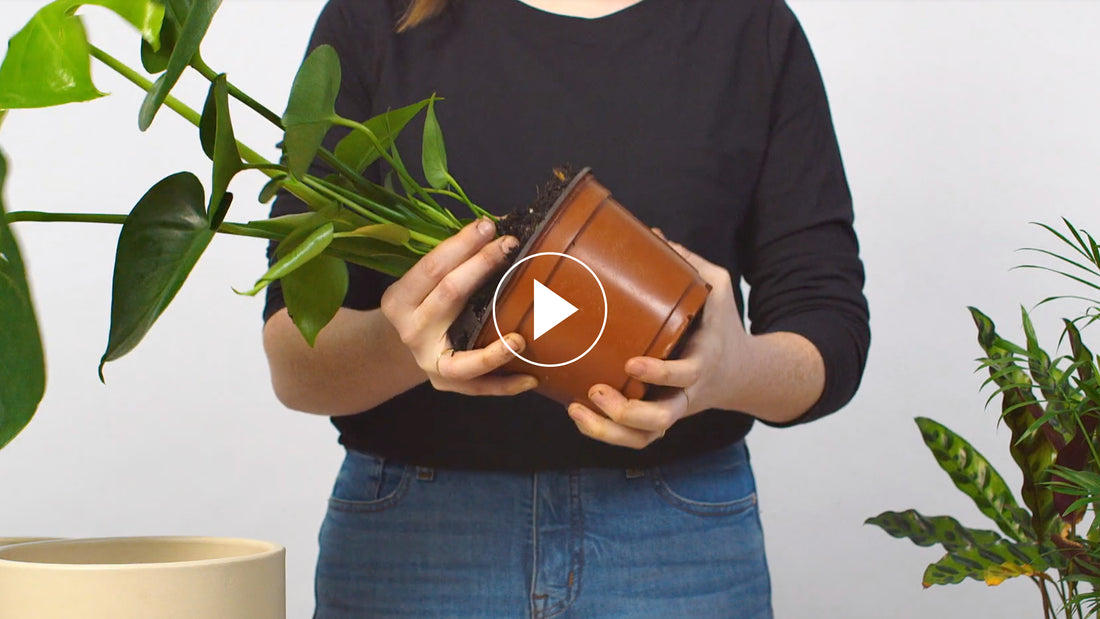
Common Care Questions
How To Repot Your Houseplant
With some simple tips and tricks, potting your houseplants is easy. If you want to switch up the decor or your plant is overgrown, proper potting is key to set your plant up for success. Let's take a look at what to know before you repot.

With some simple tips and tricks, potting your houseplants is easy. If you want to switch up the decor or your plant is overgrown, proper potting is key to set your plant up for success. Let's take a look at what to know before you pot.
Repotting your plants can sound tricky, but we have a few tips to make it a success.
First things first: repotting does not necessarily mean changing a plant’s current planter, but rather, changing its soil or potting mix. Fresh soil means new nutrients. This is great news if you love your current planter, but if you’re looking to purchase a new one that’s fine, too. If you are changing planters, try to keep the size no more than 2" larger in diameter for tabletop planters, and no more than 4" larger in diameter for floor planters. If you're repotting a very small plant, your new planter might only need to be an inch larger! The size is important here because typically when we move our plants to a larger pot with more soil, we will be inclined to water more often. A small plant + an oversized planter + lots of soil + lots of water = accidentally killing with kindness. You do not want your plant to be swimming in soil, but rather, have a little extra room to grow into for the year ahead.
Plants typically need to be repotted every 12 to 18 months, depending on how actively they are growing. Some slow growers can call the same pot home for years, but will just require a soil replenishment. Spring, before the start of the growth season, is usually the best time to re-pot your houseplants.
If you see one or a combination of these signs, you'll know it's time to repot:
- Roots are growing through the drainage hole at the bottom of the planter
- Roots are pushing the plant up, out of the planter
- Plant is growing slower than normal (different than winter dormancy)
- Plant is extremely top heavy, and falls over easily
- Plant dries out more quickly than usual, requiring more frequent waterings
- Aboveground parts of plant take up more than three times the pot space
- Noticeable salt and mineral build up on the plant or planter
Here's what you'll want handy:
- Your new houseplant, of course
- The planter you're potting into
- Fresh potting mix
- Lava rocks or similar (if your planter does not have a drainage hole)
Steps to Repot
1. Remove plant from current pot
Turn your new plant sideways, hold it gently by the stems or leaves, and tap the bottom of its current pot until the plant slides out. You might need to give it a bit of help with a couple gentle tugs on the base of the stems.
2. Loosen the roots
Loosen the plant’s roots gently with your hands. You can prune off any threadlike roots that are extra long, just make sure to leave the thicker roots at the base of the foliage. If your plant is root bound – the roots are growing in very tight circles around the base of the plant – unbind the roots as best you can and give them a trim.
3. Remove old potting mix
Remove about one third or more of the potting mix surrounding the plant. As it grew, your plant removed some of the nutrients in the current mix, so you'll want to give it fresh mix if you're potting it anyway!
4. Add new potting mix
Pour a layer of fresh potting soil into the new planter and pack it down, removing any air pockets. If your new planter doesn’t have a drainage hole, layer the bottom with lava rocks or similar (rocks, gravel, etc.) before adding the potting mix. The goal is to create crevices for the extra water to pool into, away from your plant’s roots.
5. Add plant
Set your plant that you removed from the grow pot on top of the fresh layer of mix in the new planter, making sure it's centered, then add potting mix around the plant until it is secure. Be sure not to pack too much soil into the planter, as you want the roots to breathe.
6. Water and enjoy
Even out the potting soil on top and water well! It's worth noting that a freshly repotted plant does not need to be fed fertilizer.

Words By The Sill
Empowering all people to be plant people—a collection of articles from The Sill's team of plant experts across a variety of plant care topics to inspire confidence in the next generation of plant parents. Welcome to Plant Parenthood™.
Do Some Plant Shopping